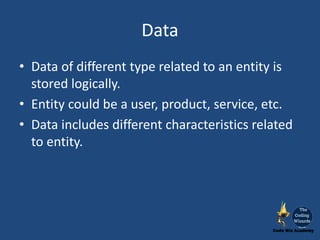What is a Database
- 1. Database
- 2. What is a database? • A database is a collection of information organised in a tabular format in the form of rows and columns. You can create database using Database Management System (DBMS).
- 3. RDBMS • RDBMS refers to DBMS that stores data in the form of tables that are connected with each other in the database.
- 4. What is data type? Data type refers to the type of data which can be stored in a column of a table.
- 5. Different Data Types • Text: Stores short alphanumeric values, such as numbers, text or a combination of both. • Memo: Stores substantial alphanumeric text, such as notes and descriptions. • Number: Stores numeric data for arithmetic calculations. A number can be either positive or negative. • Date/Time: Stores date and time values, such as Date of Birth and Date of Joining. • Currency: Stores currency values like the price of a product. • Yes/No: Stores Boolean values, such as Yes/No, True/False and On/Off.
- 6. Row and Column • A row or records represents a set of related information about a particular entry in a table. • A column or field represents a category of information or data value, related to all records. Column 1 Column 2 Column3 Column n Record 1 Record 2 Record n
- 7. Uniquely Indentify Record • A Primary Key is a column in a table which has unique values. It cannot contain NULL or blank values. A table can have only one column set as Primary Key, which is used to identify a record. UID Column 2 Column3 Column n 001 002 003
- 8. Data • Data of different type related to an entity is stored logically. • Entity could be a user, product, service, etc. • Data includes different characteristics related to entity.
- 9. Why is it important? • To get the required information at the time of need • To analyse various aspects of entity. For example: – Learning pattern – PII- Personally Identifiable Information – Progress report – Learning outcome • To inspect and improve weak points • To better cater to user needs
- 10. How to define? • Database Schema – Logically – Physically – Conceptually • Database has tables • Tables have rows and columns • Rows and columns have data inside them
- 11. For more tutorials and courses please visit: www.codewizacademy.com











